#forensic scientist
Text
Blood Spatter Analysis Overview

As I'm sure you know, blood is almost always very present at a crime scene, especially that of a violent crime. The average adult human body has about 10 pints of blood, so it's quite hard to avoid. But the quantity of blood as well as location and spatter type can give us a good bit of information on the crime, and that's what I'm here to talk about today.
Blood spatter analysis (also known as BSA) refers to the patterns, size and distribution of blood drops, stains or splatter caused by the impact of blood with an object or surface when it's flung, sprayed or projected, such as by striking someone with a weapon or during a car accident. The patterns and characteristics of blood spatter help analysts re-create the events of a crime or accident and provide further insight into the circumstances of the incident. Analysts examine the size, shape, distribution, and location of the bloodstains to determine what did or did not happen. It is one of the most effective methods of reconstructing crime scenes available to forensic analysts.
Blood spatter analysis has several applications in various fields, such as crime scene investigation, accident reconstruction, forensic pathology, and even biological research. It uses biology (behavior of blood), physics (cohesion, capillary action, and velocity), and mathematics (geometry, distance, and angle) to assist investigators in answering questions such as:
Where did the blood come from?
From what direction was the victim wounded?
How were the victim(s) and perpetrator(s) positioned?
What caused the wounds?
What movements were made after the bloodshed?
How many potential perpetrators were present?
Does the bloodstain evidence support or refute witness statements?

There are seven main categories of blood spatter: Impact spatter, passive bloodstain, projected bloodstains, cast-off bloodstains, arterial gush or spurt bloodstains, wipe bloodstain patterns, and transfer bloodstains.
There's also high, medium, and low velocity blood spatter. The velocity refers to the speed at which blood leaves the source.
A high velocity spatter is a spatter pattern with a blood impact speed of 100 feet per second or greater, originating from something like a gunshot wound. High velocity spatter usually creates small blood droplets sized 1 millimeter or less, often creating a sort of blood misting pattern.
Medium velocity spatter is a spatter with an impact speed of roughly 25 feet per second. This is often the result of blunt force trauma made with a weapon and can create cast-off patterns.
Low velocity is usually in the form of pools or dripping blood, like that of a nosebleed dripping onto the floor, with an average speed of 5 feet per second or less.
Here are examples of the aforementioned spatters:
Impact Spatter
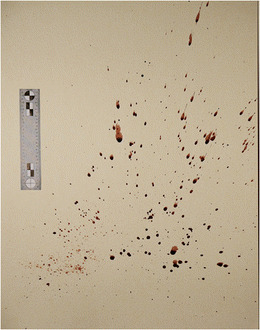
Impact spatter is the most common bloodstain pattern type in a crime scene. It is attained when an object hits the blood source and is often circular and not elongated. There are two types of impact spatter, back spatter and forward spatter. Back spatter is blood spatter that has been flung back onto the attacker or object creating the impact, and forward spatter is prohected outward and away from the source, usually exiting directly from the wound and onto nearby surfaces.
Passive Bloodstain

Passive bloodstains are low velocity blood drops, flows, and pools, typically resulting from gravity acting on an injured body. For example, these can occur from blood dripping off a stab wound.
Projectile Bloodstains
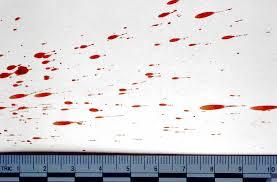
Projectile bloodstains are high velocity spatters caused by something such as arterial spurting, expirated spray, or spatter cast off an object.
Cast off bloodstains
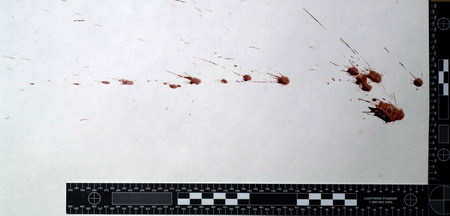
Cast-off patterns are created when the object that is used in the attack is swung, and the blood on the object is flung onto a nearby surface. These often occur in cases of blunt force trauma, where the object used is swung by the assailant. Analysts can tell the direction of the impacting object by the shape of the spatter as tails point in the direction of motion.
Arterial Spurt

Arterial spray refers to the spurt of blood released when a major artery is severed. The blood is propelled out of the breached blood vessel by the pumping of the heart and often forms an arcing pattern consisting of large, individual stains, with a new pattern created for each time the heart pumps.
Transfer Bloodstains
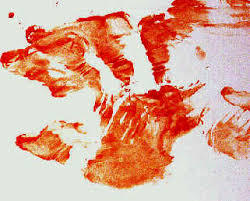
Transfer stains result from objects coming into contact with existing bloodstains and leaving wipes, swipes, or pattern transfers behind such as a bloody shoe print or a smear from a body being dragged.
The shape of the bloodstain pattern will depend greatly on the force used to propel the blood as well as the surface it lands on. Forward spatter from a gunshot wound will typically form smaller droplets spread over a wide area, while impact spatter from a bat would form larger drops and be more concentrated in the areas directly adjacent to the action.

Crime scene technicians use many different tools and methods to recreate the crime scene. To help reconstruct events, analysts use the direction and angle of the drops to determine points of convergence. (the starting point of the bloodshed)
First, the investigators must carefully examine the crime scene and locate any blood drops, stains, or splatter and collect them for further analysis.
Second, the samples are then examined in the laboratory under different light conditions and analyzed for their size, shape, speed of travel, and other characteristics. Pictures are taken from many angles, as well as alongside a ruler for perspective.
Third, experts can use various methodologies and techniques to determine the origin and direction of the blood spatter. This can include using 3D models, computer simulation, and other methods such as using strings to estimate the trajectory of the blood drops.
Blood samples are taken with Q-tips and stored in test tubes until they can be tested for a positive match to the victim, perpetrator(s), or other source.
For dried blood, a razor is often used to scrape the blood off onto a piece of paper, envelope, or other appropriate packaging.
Visual examination requires expertise and experience in the field to interpret blood stains and patterns accurately. Experimental trials involve recreating a crime scene and analyzing the results. Forensic test results can be conclusive and objective, such as DNA analysis.
In cases where the blood has been cleaned away, it can often still be found with the use of Luminol, which is not corrosive and can be applied on all types of surfaces. It can be used to detect the presence of the very small amounts of blood or bloodstains, diluted even up to 10,000 times.
The solution of luminol and the oxidant is sprayed on the area to be examined, and the iron in blood catalyses the luminescence. A test with luminol for the presence of blood was still effective eight years after deposition of blood in soil. The older the blood stain, the brighter and longer lasting the glow.
There are some cases where luminol can not detect blood, as cleaners containing “active oxygen” (such as Oxyclean, etc) will stop all means of forsensic chemical detection of human blood.
Blood spatter analysis has been admissible in court for more than 150 years, although it has recently been called into question for its validity. In the past, blood stain evidence has been misinterpreted, leading to the incarceration of an innocent, such as in the Julie Rea case. Even so, it still remains a large part of forensic investigations. Evidence should always be interpreted with great care, and with dependable spatter analysts, it continues to be a helpful tool for investigators.
#forensics#blood spatter analysis#forensic science#sherlock#dexter#criminology#deductions#deductionist#criminals#blood#criminal minds#forensic scientist#dexter new blood#criminologist#morbid#science#mortuary science#blood spatter#criminals minds#detective#bloody#BSA#sherlock holmes#science of deduction#deductive reasoning#tma#tmagp#dexter morgan
23 notes
·
View notes
Text
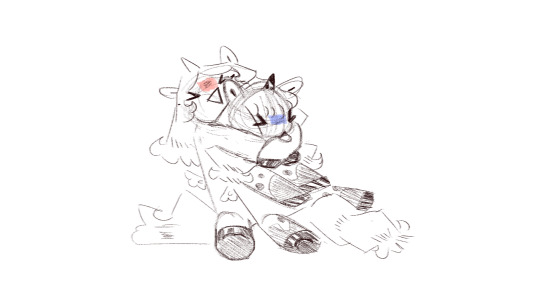
Hello, everyone! This spring will be busy for me (mostly because of uni stuff) so I will not be so active here for a while. BUT I still made one thing and it's game mockup about Tia and Luna (here called Elea & Agnieszka)!

So story is about two sisters from Europe - one prosecutor (graduated) and the second is forensic science student. They both travel to USA for internships but instead of doing practice in human world they isekai find themselves in the pony world (pre-alicorn era).

Not to waste a time, girls decide to apply their knowledge about law and enforcement into practice since local tribes - pegasi, unicorns, earth ponies - don't get along at all.

The game is a visual novel but has a lot of interaction elements like shooting from a gun, taking photos, collecting and examining evidence, debating (like in ace attorney), using smth similar of real softwares that forensic scientists use bc i don't want to be sued haha but TruView Cloud is real and I used it only as visual example.
I had this idea for a pretty long time and finally I managed to properly visualize it. I had a lot of fun headcanoning (and still have) so maybe in the future I will make a couple of more arts relating to this story and those girlies.
And for now - bye!
#mlp#mlp fim#game mockup#clip studio pro#fandom#digital drawing#digitalart#digital painting#law enforcement#visual novel#novel#prosecutor#forensics#princess celestia#princess luna#forensic science#forensic scientist#law
28 notes
·
View notes
Text
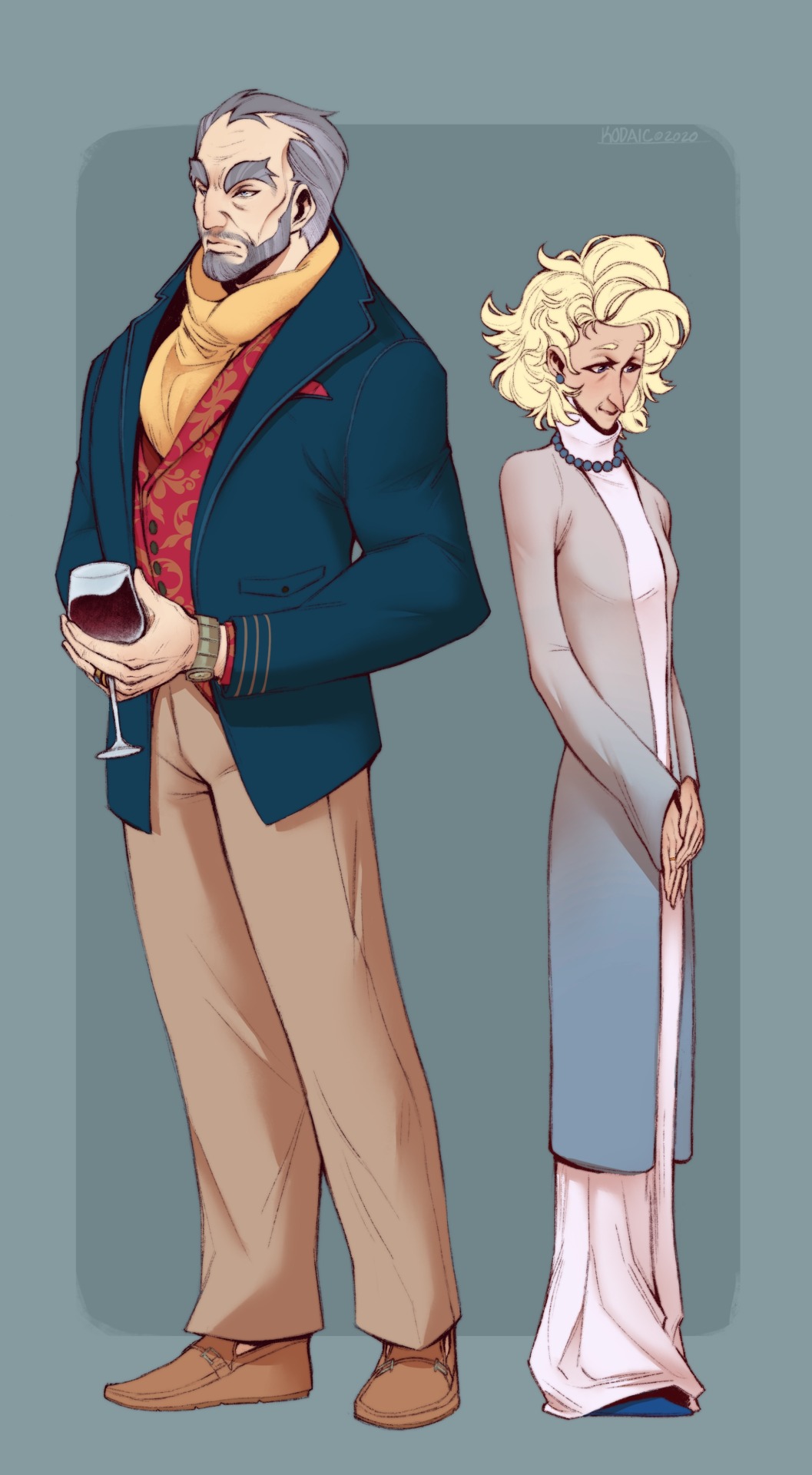
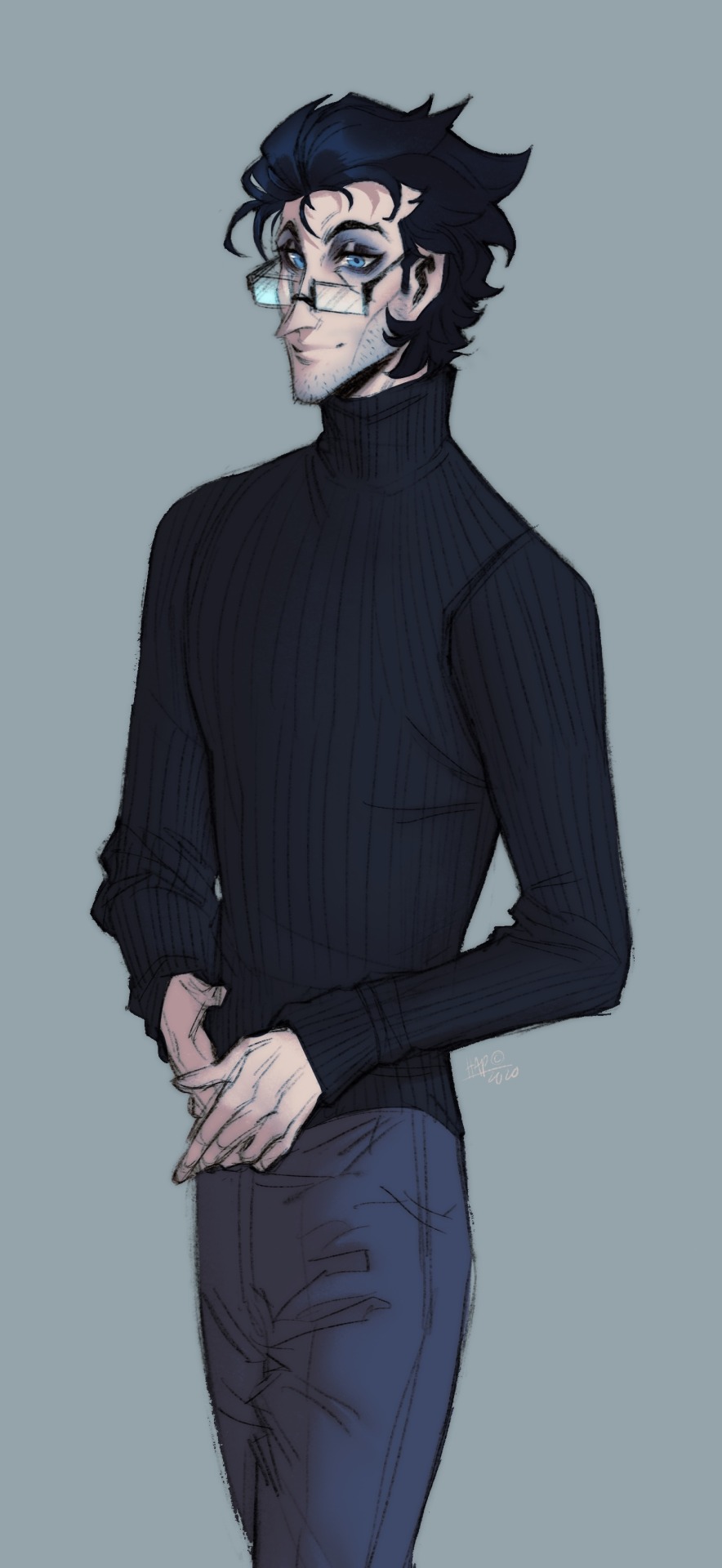







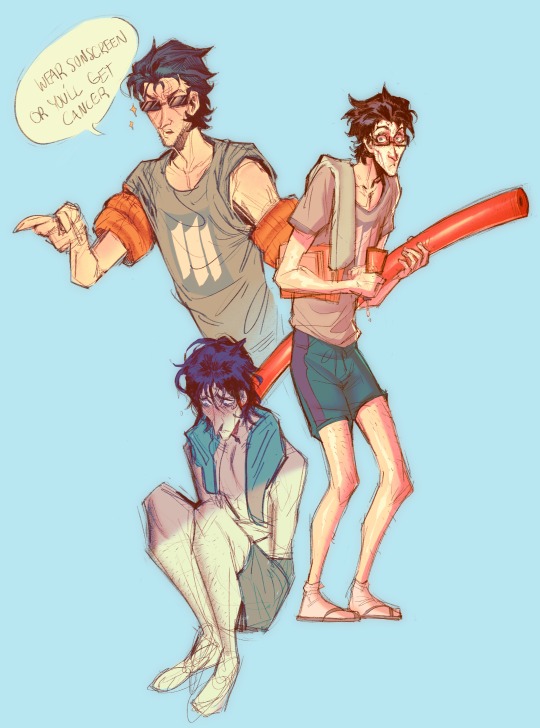

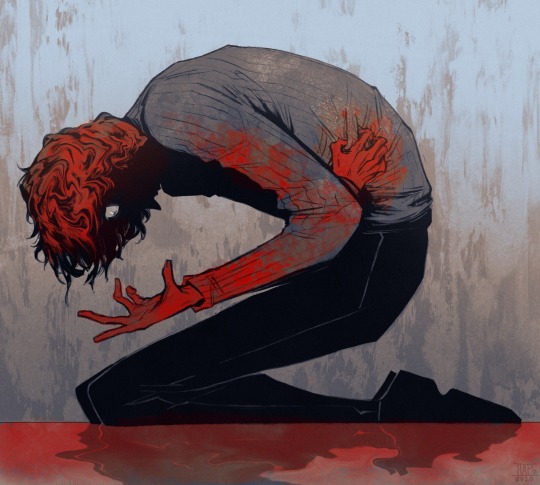
Closed Cases #1 (2020)
(Special mention that the blue haired child is @novakyuu 's character!)
#kodasea#art#own art#art compilation#sketches#artists on tumblr#2020 art#own character#cold case crew#cold case detective#detective partner#forensic scientist#medical examiner#lawrence#angela#felicia#myers#divya#arthur#madeline#cw body dysmorphia#suggestive cw#cw drinking#didn't feel like posting a lot of these individually since some bring on that pins and needles feeling that is cringe to me now#but was just having fun and figuring out some character stuff#and so we archive on to 2021#i will only ever feel joy about the rigel comic though#rigel (blue haired child) is novakyuu's!#novakyuu#ps it's not really done to my standards now but I still love myers sick burn
20 notes
·
View notes
Text
so i finally got fed up with watching criminal minds and seeing the bau mishandle evidence at a crime scene so i started writing a fic where a forensic scientist (ella lopez—iykyk) yells at the bau every time they do something wrong
current working summary:
5 times the bau was reprimanded for improper evidence handling (by a forensic scientist) + 1 time the forensic scientist got revenge
sincerely, a forensic scientist in training (me. i’m the forensic scientist in training. working on my forensic science degree rn)
#criminal minds#cm#bau#bau team#ella lopez#forensics#forensic science#forensic scientist#i’m a forensic science major#so therefore i’m qualified to be mad about this#criminal minds fanfiction#while we’re at it garcia and ella would be best friends if they ever met#i wrote almost 1000 words last night in a writing fever haze#and then another 1000 today#but that was more of a rewrite of the first part now that i have a more structured plot in mind#low key very excited about this#i’ll keep y’all updated
10 notes
·
View notes
Text
So today I was like "huh I wonder if there are suggested careers for autistics" so I looked it up and lo and behold there were lists. First one I pulled up nearly half the careers were ones I'd either considered in the past or are ones I'm currently considering and I lost my shit
Told my mom and she was like "yeah for I while I thought you were pulling from that list" and I-
!!!!! No!!!!!!!! I wasn't!!!!!!! I'd never even thought about that before!!!!!!!
#losing my mind#actually autistic#actually autism#gardening#horticulture#mechanical engineering#car mechanic#automotive technician#forensic scientist#carpenter#accountant#librarian
50 notes
·
View notes
Text
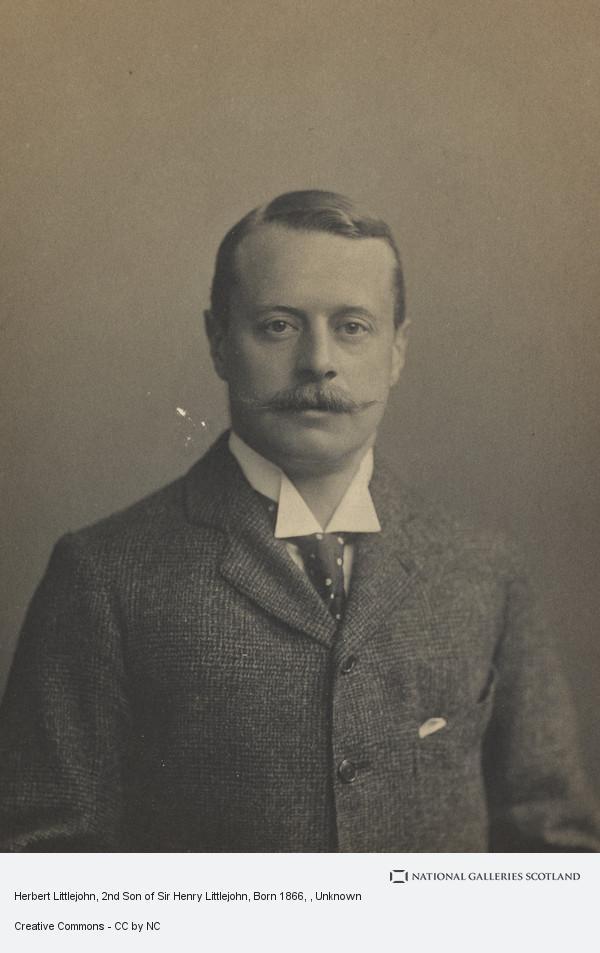
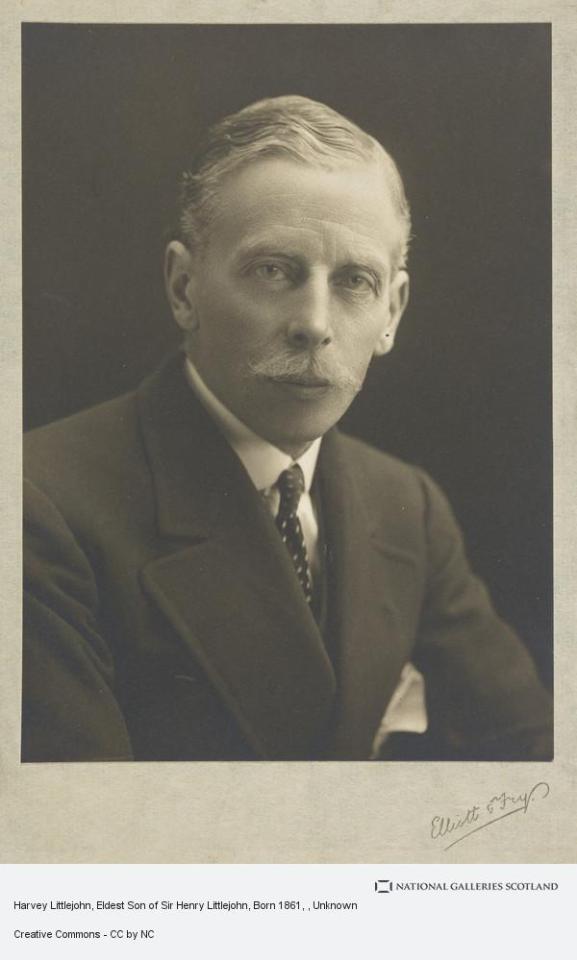
Henry Duncan Littlejohn was born in Edinburgh on May 8th 1826, Littlejohn is one of two Edinburgh men that are quoted as being an influence in Arthur Conan Doyle’s formation of the character Sherlock Homes.
Henry was educated in Perth before The Royal High school and the Edinburgh University studying medicine and graduating with distinction in 1847.
It’s quite a topical post given that Henry Littlejohn, whose appointment as the first Medical Officer of Health for Edinburgh was the first appointment of its kind in Scotland. He pioneered compulsory notification of infectious disease in Edinburgh leading to the introduction of such notification throughoutt Britain. The resultant mapping of diseases allowed active prevention and led to significant reduction in mortality during the 50 years of his office. He also achieved distinction in Forensic Medicine as an expert Crown witness for most of the major Scottish trials in the latter half of the 19th century.
Eloquent and erudite, he was regarded as an outstanding teacher amidst Edinburgh contemporaries who included some of the greatest medical teachers in the world.
In 1879 due to his influence a clause was included in the local Police Act requiring such notification giving Edinburgh the lead to the whole of Great Britain. This was to prove one of the major advances in public health of the 19th century. His “Report on the Sanitary Condition of the City of Edinburgh” proved a blueprint for social reform. It clearly demonstrated the effect of population density on the spread of disease and mortality. He was able to define the incidence of dip patients throughout the city and demonstrated a clear correlation between deprivation, disease and mortality. His proposals to improve this included recommendations about building, sewage, water pollution and limiting overcrowding. The Town Council were responsive to his recommendations and demolished many aging properties which had become dangers to health.
By the time of his retiral in 1908, after 46 years of service, mortality rates in Edinburgh from infectious disease had halved. Largely as a result of his efforts cholera and typhus had disappeared and smallpox had become a rarity.
The other inspiration I mentioned earlier, for Sherlock Holmes gets a mention here in this article about both him and Liltlejohn
#scotland#scottish#surgeon#forensic scientist#scientist#scientist.#edinburgh#history#sherlock holmes
10 notes
·
View notes
Text
My one true love 🥺


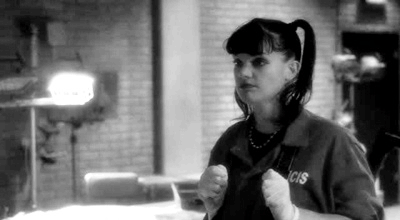

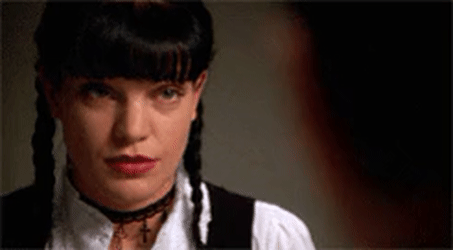


28 notes
·
View notes
Note
Do you like bugs
I read 'Do you like drugs' at first. And the answer to both questions is yes. Insects can be also very important for the field of criminal investigation, by determining the time of death with the larvae of calliphora vicina and cynomya mortuorum.
#rp#roleplay#sherlock roleplay#sherlock rp#forensic scientist#forensic#sherlock holmes#sherlock#bbc sherlock#sherlock answers#sherlock answering asks
20 notes
·
View notes
Text

2 notes
·
View notes
Text
Hello beautiful people,
As part of my forensics coursework I have been tasked with researching a horrible IRA bombing, the Omagh Bombing in 1998. I know its horrible to ask but if anyone has any information on it (yes I am doing my own research of course) Id love to hear from you.
Im sorry if it brings up horrible memories for some who may have experienced it or it affected family members, and I can show evidence that Im truely researching this for university.
Thanks in advance
#forensics#forensic science#forensic scientist#forensic investigation#university#uni#ira#ira bombing#bombing#terrorist#terrorist attack#omagh#omagh ira
4 notes
·
View notes
Text
youtube
0 notes
Text
Outta Nowhere AU
Main Masterlist
Decks vs. Honeybee reader distinctions

You Catch More Bees With Honey
(Mob! Bucky x Farmer! Reader)

Handiwork
(Mechanic! Farmhand! Curtis x Bartender! Reader)
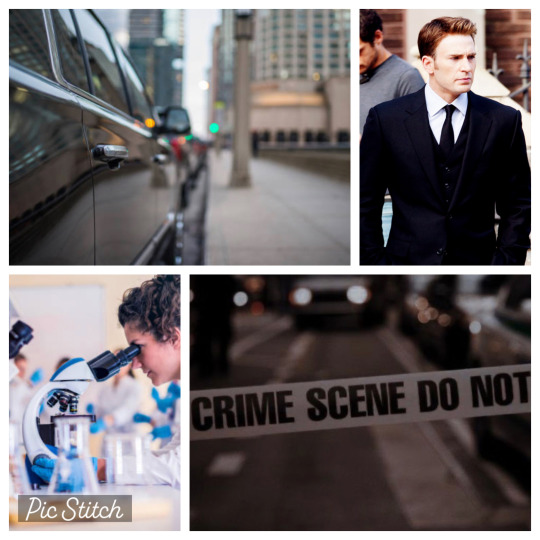
The Rainmaker
(Mob! Steve x Forensic Scientist! Reader)
#outta nowhere au#bucky barnes#steve rogers#curtis everett#you catch more bees with honey series#handiwork series#you catch more bees with honey#handiwork#the rainmaker#the rainmaker series#Bucky Barnes x reader#Bucky Barnes x you#Curtis Everett x reader#Curtis Everett x you#steve rogers x reader#Steve rogers x you#bucky barnes fanfiction#curtis everett fanfiction#Steve rogers fanfiction#mob AU#mafia AU#mob bucky x farmer reader#mob Steve x forensic scientist reader#mechanic farmhand Curtis x bartender trader#chris evans#sebastian stan#AU Masterlist
81 notes
·
View notes
Text
I think my favorite sub-genre of detective shows, besides the classic "grisly murders keep happening in absurdly picturesque villages", is "person who has absolutely no business being at a crime scene pairs up with a detective and provides surprising help from their actual area of expertise, and thoroughly annoys the cops while doing so"
#bonus points if its an old-timey show where the tag along represents a field now included in crime solving#like psychologist or (forensic) scientist#in other news grantchester is back on sunday hooray#mood#grantchester#vienna blood#father brown
271 notes
·
View notes
Text
CSI: Bobby
forensic scientist!robert 'bob' floyd
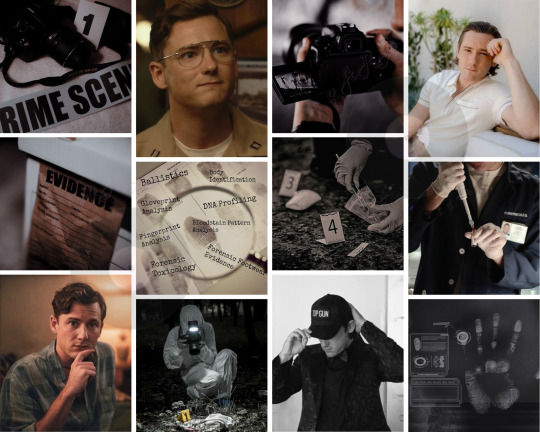
i can kill you in 70 different ways and not leave a single trace of evidence behind
bob floyd had always been fascinated by science. it was the art of discovery and learning. he loved all branches of the subject, but chemistry and physics were his favorites
one was based in learning how things worked in the world. how things reacted to each other, with each other. and what they were composed of and how to break them down. the other was based on learning how the world worked on things. how those things reacted to the circumstances and conditions around them.
biology snuck in at third place later when he got to ninth grade.
and the human body was such a complex yet simple thing. a near perfect combination of his two loves.
and then later his sophomore year of high school he went on a field trip to the local crime lab when his science class was doing a unit on DNA.
and that is when he found his true love.
forensics
======
and thank you to @desert-fern for giving me this idea! 💜
#vinny's moodboard multiverse#vinny creates#week 9#week nine#robert floyd#robert bob floyd#bob floyd#forensic scientist!robert bob floyd#csi: bobby#csi au#AU#top gun maverick#top gun maverick moodboard#bob floyd moodboard#lewis pullman#sarahsmi13s
56 notes
·
View notes
Photo
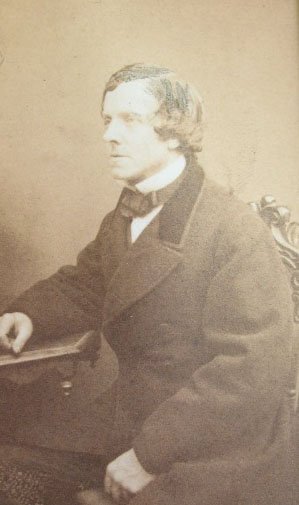

Henry Duncan Littlejohn was born in Edinburgh on May 8th 1826, Littlejohn is one of two Edinburgh men that are quoted as being an influence in Arthur Conan Doyle’s formation of the character Sherlock Homes.
Henry was educated in Perth before The Royal High school and the Edinburgh University studying medicine and graduating with distinction in 1847.
It’s quite a topical post given that Henry Littlejohn, whose appointment as the first Medical Officer of Health for Edinburgh was the first appointment of its kind in Scotland. He pioneered compulsory notification of infectious disease in Edinburgh leading to the introduction of such notification throughoutt Britain. The resultant mapping of diseases allowed active prevention and led to significant reduction in mortality during the 50 years of his office. He also achieved distinction in Forensic Medicine as an expert Crown witness for most of the major Scottish trials in the latter half of the 19th century.
Eloquent and erudite, he was regarded as an outstanding teacher amidst Edinburgh contemporaries who included some of the greatest medical teachers in the world.
In 1879 due to his influence a clause was included in the local Police Act requiring such notification giving Edinburgh the lead to the whole of Great Britain. This was to prove one of the major advances in public health of the 19th century. His “Report on the Sanitary Condition of the City of Edinburgh” proved a blueprint for social reform. It clearly demonstrated the effect of population density on the spread of disease and mortality. He was able to define the incidence of dip patients throughout the city and demonstrated a clear correlation between deprivation, disease and mortality. His proposals to improve this included recommendations about building, sewage, water pollution and limiting overcrowding. The Town Council were responsive to his recommendations and demolished many aging properties which had become dangers to health.
By the time of his retiral in 1908, after 46 years of service, mortality rates in Edinburgh from infectious disease had halved. Largely as a result of his efforts cholera and typhus had disappeared and smallpox had become a rarity.
The other inspiration I mentioned earlier, for Sherlock Holmes gets a mention here in this article about both him and Liltlejohn
https://www.scotsman.com/whats-on/arts-and-entertainment/edinburghs-henry-littlejohn-was-also-inspiration-sherlock-holmes-899472
11 notes
·
View notes
Text
@visceravalentines
12 notes
·
View notes